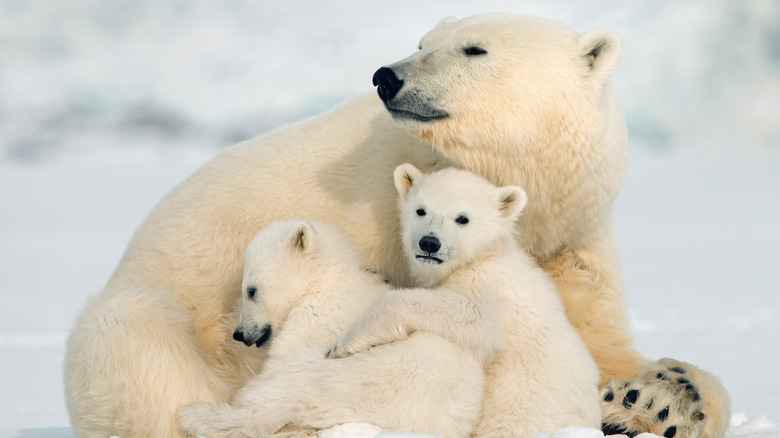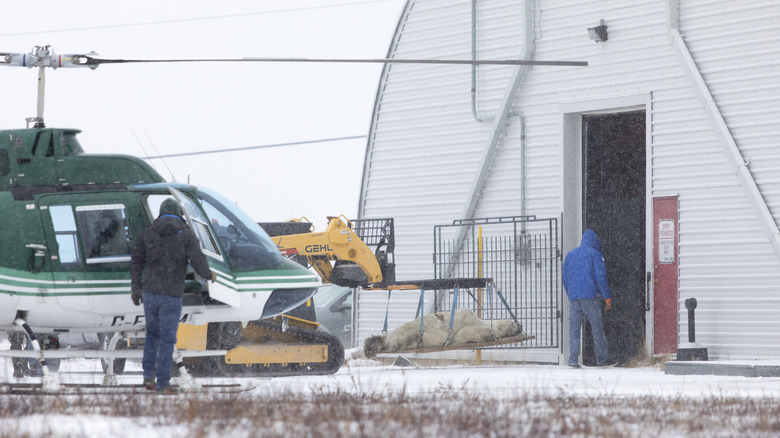Polar Bears On The Wrong Side Of The Law Might Find Themselves In Canada's Polar Bear 'Jail'
Over its long history, this planet has been home to a huge range of formidable predators. The iconic Tyrannosaurus Rex is perhaps the most famous example of all, per the U.K.'s Natural History Museum, weighing a mighty 15,000 pounds and measuring 40 feet long.
Outside of questionable science from beloved movies, we don't tend to see many Tyrannosaurus Rex specimens roaming today. Dinosaurs may have been gone for millions of years, but today's world is home to equally magnificent carnivores.
The polar bear, according to the World Wildlife Fund, is the biggest living land predator. The males of the species are much larger than the females, tipping the scales at more than 1,700 pounds. They are magnificent, powerful animals, and though they don't make a habit of interacting with humans, encounters do happen. To preserve human lives and property, it is sometimes necessary to take precautions. One of the most extraordinary precautions is a Canadian polar bear jail of sorts.
When polar bears and humanity collide
Humanity and polar bears have shared a troubled relationship at times. The Young People's Trust For The Environment reports that polar bears were heavily hunted, to the extent that, in 1970, it was estimated that no more than 10,000 remained. A 1973 ban on their hunting (which did not include the Inuit people, who live alongside them) saw their numbers begin to recover to around threefold.
Nevertheless, the outlet goes on, factors such as climate change continue to threaten them, and visits to the region of their habitats have become more popular. This also means that people come into closer contact with the bears more often, which can be very dangerous. The bears can also approach human settlements at times, to the same potentially hazardous effect.
To help prevent the two species colliding in deadly fashion, Canada devised the world's only polar bear jail. According to Stuart Forster of Go Eat Do, it's located in the region of Churchill Airport in Manitoba, and is officially dubbed the Polar Bear Holding Facility.
The Polar Bear Holding Facility: A far more humane answer
Go Eat Do explains that Canada's Churchill is affectionately known as the Polar Bear Capital of the World. Unsurprisingly, then, the noble animals are frequently seen in the area, and certain measures have long had to be employed to manage the furry population. In October and November, the bears are often sighted as they prepare for seal-hunting season — the ice reportedly just forming at this point.
District Supervisor Conservation Officer Brett Whitlock, per Go Eat Do, leads the Polar Bear Alert Program. "In the late-60s, there were a few polar bear-human encounters, including one fatality ... the government of the day decided they wanted to do something to protect people around the community." At the time, according to Whitlock, the Polar Bear Control Program was considered to be the answer. Sadly, "control" seemed to consist of killing up to 15 of the bears each year.
The following decade, a more humane solution was devised. What essentially had been a storage warehouse was purchased and converted into the Polar Bear Holding Facility in 1979.
The rules of the polar bear 'jail'
Churchill Polar Bears states that Manitoba Conservation is sworn to protect both Churchill residents and the bears. Staff first attempt to simply lead the bears to leave the vicinity by firing harmless, noisy shots. Baited traps are also employed, but should this be unsuccessful, or should people or bears be in danger, the polar bear is tranquilized and transferred to the Polar Bear Holding Facility.
The facility, according to the outlet, can hold up to around 30 animal in both individual or "family" cells, and can provide both heating or air conditioning, depending on the time of year. Visitors are not allowed in the building, so that the bears don't become habituated to human contact. The bears are given water, but no food, and are check on daily. After around 30 days they are taken back out into Hudson Bay when conditions are right for them, and are kept for longer or shorter periods, depending on what's best for both the animals and the locals of Churchill.
The policy, Brett Whitlock told Go Eat Do, is "keeping them for a period of time that's determined by the bear's history; what they did to get into the holding facility and the current number of bears in the facility." Whitlock estimates that about 50 specimens are held each year, and a total of approximately 2,000 have been "guests" overall. Churchill Polar Bears reports that the team also focuses on informing the community and visitors on bear safety, all in the interest of keeping human and beast alike safe and allowing them to thrive — away from each other.



